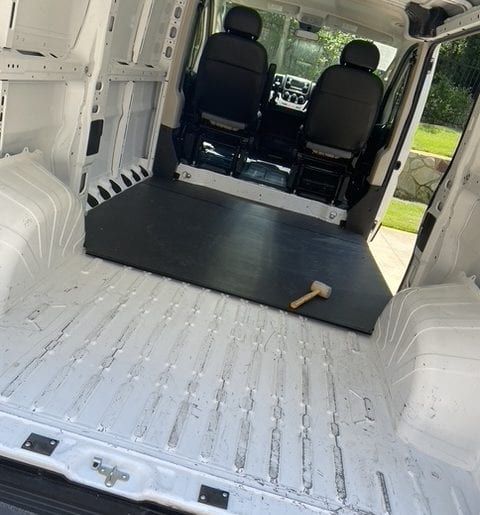Like most mobile DJs, I started out as a hobbyist playing music for fun on the weekends. Even back in my college days performing live music at bars, I could once fit everything I needed for a gig into my Geo Prizm. Then a Toyota Camry. Then a 4Runner. Then a Sequoia. Then…I was renting a lot of Uhauls. Almost every weekend. It got old. And Expensive — on not just my bank account, but on my time and my body.
Using a personal vehicle for your business is great in many ways. The cost is low. It’s easy to park and store, and it’s always with you. But how much time do you spend loading it up every Saturday morning? Or unloading it late Saturday night? Or Sunday morning? Or finally leaving your house on Monday and realizing that it’s still full of speakers and lights?
Renting large vans or box trucks can expand your capacity but how much time are you spending to go pick up your rental? And bumming a ride (or hailing an Uber) over there? Then driving home, loading up, unloading after the gig, returning it at 3 AM…or just being too lazy to care about the late fees and taking it back the next day, missing precious Sunday couch time at home?
I’m sure other DJs can feel this pain. With most all of us suffering from GAS (Gear Acquisition Syndrome) and the general desire to grow our service offerings and capabilities, we’re all likely carrying around more gear than when we started.
I considered various options for making some changes. They all have their advantages and disadvantages:
- Trailers: very low cost, very easy to load (low to the ground). But often broken into, and very difficult to maneuver and park in certain situations.
- Box Trucks: moderately low cost and often equipped with ramps for easy unloading, the most cargo space out there, but generally noisy, and won’t fit in many parking structures.
- Cargo Vans: relatively expensive and usually require some customization, but can ultimately be a very complete solution to make for a very comfortable, convenient, and effective gear transportation solution for Mobile DJs.
My Experience Building out a 2019 RAM ProMaster
I learned a lot in the process of shopping for and customizing my 2019 RAM Promaster, and I’m happy to share my experience with other DJs here. Everyone has different needs and what works best for me may not be best for you, but these are all things to consider along the way:
There were a few factors that I considered when purchasing my vehicle:
Cargo Space
Not all cargo vans are created equal. Take inventory of EVERYTHING that you plan to transport in your vehicle. Take measurements, factor in at least 10% wiggle room for easy access, and be very realistic about how easy this is going to be to work with. For example, I have a large mobile booth that stands 48” tall. The first van that I was considering had a rear cargo height of 53”, but with the load-in angle, it wasn’t nearly tall enough. The RAM Promaster (Low Roof edition) had an internal Cargo height of 65”- almost a foot and a half of clearance for the largest part of my load.
Overall Vehicle Dimensions
So Dan, why didn’t you just but the high roof edition? Well, I considered it. It was going to make life very easy- until I couldn’t fit my van into my own garage, a parking garage- or let’s be honest- a late night drive thru! I chose a model that was tall enough to fit all my gear, yet low enough to fit into a standard 8’ garage door height.
Load Height
If you are loading gear into the back of a vehicle, you’ll definitely want to consider the height of the cargo deck from the ground. And will you be needing a ramp to get your gear in? See below- because if so, you may need to do some high school trigonometry!
Next post: So I bought the van — now what?
The owner of DQB Entertainment in Dallas, Dan Quinn once pranked the kids in his DJ School by informing them that Marshmello and Imagine Dragons had been removed from the library.
DJ Times Magazine is copyright © 2020 by DJ Publishing, Inc. www.djtimes.com








